
Wine Culture and Information since 2002 - Volume 22
 Wine Culture and Information since 2002 - Volume 22 |
|
Contrasts of Orvieto Classico Superiore and Verdicchio di MatelicaUmbria and Marche are compared in the glasses of this month's tasting by contrast with two white wines, among the most famous and celebrated of the respective regions |
|
The enological scenario of central Italy – by of course considering the well-known exceptions – is historically and generally committed to grapes and white wines. Tuscany excluded, the enological history of most regions of central Italy is characterized by white wines. In modern times things have considerably changed and the wine-growing areas of central Italy and traditionally committed to the production of white wines have expanded – so to speak – their enological offer by also including reds. Something that has not generally happened, at least not substantially, for the territories historically committed to red wines, which introduced whites and however strongly retaining the original identity of land of reds. In this regard, it must be said it has often been a market need, with the aim of satisfying the alternation of consumption which, cyclically, favors both white and red. This month, in the glasses of our tasting by contrast, we are going to pour the wines of two of the most famous areas committed to the production of whites and, in both cases, with a long wine making history. Orvieto and Verdicchio di Matelica – the two wines we will analyze this month – have a long and well established history and, in the case of Orvieto, even dated back to Etruscan times. In any case, these are very different wines having in common only the color. The wines of Orvieto, in all the styles allowed by the production disciplinary, are made of many varieties – traditionally five – while Verdicchio di Matelica is produced only with the homonymous and famous grape of Marches. Of course these are very different wines, not only for the composition of the grapes, but also for the wine making interpretation and the characteristics of the respective territories. Both wines prove to have a good wine making versatility, in fact they express this quality by means of many enological interpretations, from dry and sparkling wines to sweet ones from dried grapes, including those attacked by noble rot.
|
|
Orvieto wines are undeniably among the oldest ones in the history of wine in Italy. Produced since the times of the Etruscans, the white wines of this evocative area in Umbria are still today among the best known in the world. The wines of Orvieto have gained appreciation in all eras of history and, moreover, they are among the most celebrated ones. Even in relatively modern times, the wines of Orvieto represented – in the common imagination and together with a few others – the emblem of Italian wine par excellence. Built on the huge hill of tuff and clay, Orvieto, in addition to the beauty of the area and its monuments, is identified with its white wine which, as mentioned, was already produced by the Etruscans, who dug the famous caves in the tuff used both for vinification and keeping. The ancient Etruscan caves are in fact still used today by some wineries, thus perpetuating millennia of uninterrupted history in honor of wine. In the composition of the “modern” Orvieto wine we find typical grapes of Umbria and central Italy: Trebbiano Toscano – here called Procanico – and Grechetto which, according to the disciplinary, must make at least 60% of the wine. Orvieto is completed by white grapes permitted for cultivation in Umbria region. The grapes which traditionally complete Orvieto are Malvasia Bianca, Canaiolo Bianco and Verdello; today, however, we also find other varieties, including the international ones such as Chardonnay. Orvieto has a decidedly interesting enological versatility, thanks to both the characteristics of the soil and the particular climate of this territory, qualities that favor – among the very few in Italy – the development of noble mold in the grapes without making them rot. The wines of this area are also suited to fermentation and aging in wood, a practice that, it must be said, is rarely used by producers. Finally, the wines of the denomination Orvieto Classico are produced in the historical territory – corresponding to the one around the famous “Rupe di Orvieto” – while the Superiore is reserved for wines from harvests with maximum yields of 80 quintals per hectare and minimum alcohol by volume of 11%.
|
||||
|
Matelica is one of the two territories of the Marches exclusively committed to a single grape and a single wine: Verdicchio. Wine of Denominazione d'Origine Controllata (Denomination of Controlled Origin), the territory of Matelica however differs from the one of the much wider denomination of Castelli di Jesi. The differences, of course, are not only about the territory but, above all, the wine itself, as the two areas make decidedly different wines. Verdicchio di Matelica is in fact considered a Verdicchio from the mountain, while the one of Castelli di Jesi is a Verdicchio from the sea. Same grape, two extremely different wines. Verdicchio di Matelica stands out for its pleasing crispness given by acidity and an alcohol content generally lower than the one made in Castelli di Jesi. This undeniably is because of the effect of territory, soil and climate typical in the Umbrian-Marches Apennines. Verdicchio di Matelica is recognized as Denominazione d'Origine Controllata wine (Denomination of Controlled Origin) and has been, together with Rosso Conero, the first wine of the Marches to achieve this recognition in 1967. In this regard, it should be noted that, since 2009, in the same territory is also produced Verdicchio di Matelica Riserva, recognized as a Denominazione d'Origine Controllata e Garantita wine (Denomination of Controlled and Guaranteed Origin, DOCG). At the base of this interesting wine we evidently find Verdicchio grape, one of the most interesting white berried varieties of the Italian wine scene. Thanks to its characteristics, allowing it to make structured wines with a good longevity potential, it is often called “a red dressed in white”, and Verdicchio di Matelica, of course, is no exception to this. This wine – not to be confused with the Riserva style which belongs, in fact, to another denomination – is usually vinified in inert containers, a practice favoring, among the other things, both the expression of the Verdicchio's aromas as well as the characteristic crispness given by acidity.
|
Let's choose the two wines for the tasting by contrast of this month, a choice that – undoubtedly – is not so difficult as the two wines – Orvieto Classico Superiore and Verdicchio di Matelica – can be easily found in any wine shop. However, we will pay attention to the composition of the wines, the vintage and the container used for aging. As for Orvieto Classico Superiore, this wine is being produced with the union of many grapes and, besides the two main varieties – Procanico, that is Trebbiano Toscano, and Grechetto – we will make sure Malvasia Bianca, Canaiolo Bianco and Verdello are also found in the composition. We will therefore choose an Orvieto Classico in the very meaning of it, that is, produced with the grapes that traditionally and typically are used for its making. The choice of Verdicchio di Matelica is generally simple as, in most of the cases, we find in its composition this grape only, however it is good to notice its production disciplinary provides for a minimum of 85% of Verdicchio. Both wines belong to the latest harvest available and vinified in steel tanks. Orvieto Classico Superiore and Verdicchio di Matelica are served in tasting glasses at a temperature of 10 °C (50 °F). Let's pour the two wines into their respective glasses and start the tasting of this month by evaluating the appearance of Orvieto Classico Superiore. We tilt the glass over a white surface – a sheet of paper is enough – and observe the wine at the base. The Umbrian wine shows a brilliant greenish yellow color and a very high transparency: the object placed between the glass and the white surface is perfectly visible. Let's now evaluate the nuance of Orvieto Classico Superiore by observing the wine towards the opening of the glass, at the point where the thickness of the liquid mass becomes thinner. Also in this case the Umbrian wine confirms, in the nuance, the greenish yellow color. Let's now pass to the evaluation of the appearance of Verdicchio di Matelica and tilt the glass over the white surface. The color of the wine from Marches is more intense than the Umbrian one and, in this case, can be observed a bright straw yellow color, with a very high transparency. The nuance of Verdicchio di Matelica, observed towards the opening of the glass, reveals, again, a straw yellow with an evident hint of greenish yellow. Orvieto Classico Superiore and Verdicchio di Matelica are characterized by very different olfactory profiles. In the first case, it is the result of many varieties, each of them having their own olfactory qualities, although having in common some characteristics. In the second, however, we generally find Verdicchio only, therefore the identification, so to speak, becomes simpler. In this regard, it should be noted that the exercise of the sensorial evaluation of multi-varietal wines is decidedly important, in particular for the study of the overview of all aromas and how they interact with each other. Orvieto Classico Superiore and Verdicchio di Matelica are characterized by sensations reminiscent of the world of flowers and fruits, especially those with white pulp. In both cases we also find hints of nuts, in particular, in Orvieto Classico Superiore is often perceived the aroma of hazelnut – generally given by Grechetto – while in Verdicchio di Matelica we perceive almond, typical aroma of this variety and which is sometimes also found in the Umbrian wine and, specifically, associated with Procanico grapes. Let's resume the tasting by contrast of this month and proceed with the analysis of the olfactory profiles of Orvieto Classico Superiore and Verdicchio di Matelica, starting – just like the previous phase – from the Umbrian wine. By keeping the glass in vertical position and, without swirling it, we do the first smell in order to evaluate the opening of the wine. Orvieto Classico Superiore gives the nose intense and pleasing aromas of apple, plum and hawthorn. Let's now swirl the glass, in order to favor the development of the other aromas, and proceed with the second smell. The olfactory profile of this wine is completed with pear, peach, hazelnut and broom as well as pleasant mineral hints and a touch of rosemary. Let's move on to the evaluation of the olfactory profile of Verdicchio di Matelica and perform the first smell in order to evaluate its opening. From the glass emerge intense and clean aromas of apple, pear and hawthorn, very pleasing. After having swirled the glass and performed the second smell, the olfactory profile of Verdicchio di Matelica is completed with plum, broom, peach, pineapple and almond. Let's now proceed with the evaluation of the gustatory profiles of the wines of our tasting by contrast, starting from Orvieto Classico Superiore. The first aspect we evaluate is the attack – that is, the initial sensations perceived in the mouth – and, to do this, we take a sip of the Umbrian wine. Orvieto Classico Superiore is characterized by a crisp attack of good acidity and structure, in which the effect of alcohol, well perceptible, contributes to the balance of the wine. In the mouth we also perceive the flavors of apple, peach and plum, therefore confirming the correspondence to the nose. Let's now pass to the evaluation of the attack of Verdicchio di Matelica and take a sip of the wine from Marches. In the mouth we perceive a decidedly prominent sensation of crispness in addition to the good structure. The effect of alcohol, less intense than in Orvieto Classico Superiore, is however enough to give the wine a good balance. In the mouth, moreover, we perceive the flavors of apple, pear and almond, also in this case confirming the good correspondence to the nose. Finally, note the pleasing mineral sensation which is perceived in both wines. The last phase of the tasting examines the intensity and quality of the sensations that the wines leave in the mouth after swallowing, in particular, the taste-olfactory persistence, that is, the amount of time during which the sensorial characteristics of the wines continue to be clearly perceived in the mouth. The finish of the Orvieto Classico Superiore is characterized by a good taste-olfactory persistence in which the flavors of apple, pear, plum and hazelnut are perceived, often with a hint of almond. We also continue to perceive the crispness of the acidity of the wine, kept in balance by the effect of alcohol, as well as a pleasing sensation of minerality. The finish of Verdicchio di Matelica is persistent, leaving the pleasing crispness of acidity in the mouth, more evident than the Orvieto Classico Superiore, in addition to the pleasing flavors of apple, plum, almond and a hint of minerality. Before ending the tasting, let's evaluate again the two wines, on the nose and on the taste: the differences between Orvieto Classico Superiore and Verdicchio di Matelica are even more evident.
|
||||||||
Wines of the Month |
|
|
|
Score legend Prices are to be considered as indicative. Prices may vary according to the country or the shop where wines are bought |
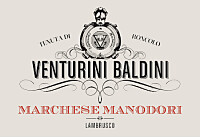
|
|
Reggiano Lambrusco Frizzante Marchese Manodori 2019 |
|
| Venturini Baldini (Emilia-Romagna, Italy) | |
 Lambrusco Marani, Lambrusco Maestri, Lambrusco Salamino, Lambrusco Grasparossa Lambrusco Marani, Lambrusco Maestri, Lambrusco Salamino, Lambrusco Grasparossa | |
| Price: € 8.50 | Score: |
 Intense ruby red and nuances of purple red, moderate transparency. Intense ruby red and nuances of purple red, moderate transparency. Intense, clean, pleasing, refined and elegant, starts with hints of
cherry, blueberry and violet followed by aromas of blackberry, raspberry,
strawberry, cyclamen, plum, pomegranate, carnation, cinnamon and white
pepper. Intense, clean, pleasing, refined and elegant, starts with hints of
cherry, blueberry and violet followed by aromas of blackberry, raspberry,
strawberry, cyclamen, plum, pomegranate, carnation, cinnamon and white
pepper.
 Effervescent and properly tannic attack, however balanced by alcohol,
good body, intense flavors, pleasing crispness. Effervescent and properly tannic attack, however balanced by alcohol,
good body, intense flavors, pleasing crispness.
 Persistent finish with flavors of cherry, blueberry and raspberry. Persistent finish with flavors of cherry, blueberry and raspberry. Produced with the Charmat method. Produced with the Charmat method. |
|
 Cold cuts, Stuffed pasta with meat, Stewed meat, Boiled meat Cold cuts, Stuffed pasta with meat, Stewed meat, Boiled meat |
|
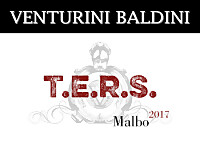
|
|
Colli di Scandiano e Canossa Malbo Gentile T.E.R.S. 2017 |
|
| Venturini Baldini (Emilia-Romagna, Italy) | |
 Malbo Gentile Malbo Gentile | |
| Price: € 24.00 | Score: |
 Intense ruby red and nuances of ruby red, little transparency. Intense ruby red and nuances of ruby red, little transparency. Intense, clean, pleasing, refined and elegant, starts with hints of
plum, blueberry and blackberry followed by aromas of violet, pomegranate,
cyclamen, raspberry, black cherry, carob, tobacco, cinnamon, vanilla
and menthol. Intense, clean, pleasing, refined and elegant, starts with hints of
plum, blueberry and blackberry followed by aromas of violet, pomegranate,
cyclamen, raspberry, black cherry, carob, tobacco, cinnamon, vanilla
and menthol.
 Properly tannic attack and however balanced by alcohol, good body,
intense flavors, pleasing crispness. Properly tannic attack and however balanced by alcohol, good body,
intense flavors, pleasing crispness.
 Persistent finish with flavors of plum, blueberry and blackberry. Persistent finish with flavors of plum, blueberry and blackberry. 24 months in cask. 24 months in cask. |
|
 Broiled meat and barbecue, Roasted meat, Stewed meat with mushrooms, Hard cheese Broiled meat and barbecue, Roasted meat, Stewed meat with mushrooms, Hard cheese |
|
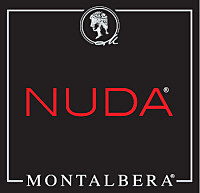
|
|
Barbera d'Asti Superiore Nuda 2016 |
|
| Montalbera (Piedmont, Italy) | |
 Barbera Barbera | |
| Price: € 21.00 | Score: |
 Brilliant ruby red and nuances of ruby red, moderate transparency. Brilliant ruby red and nuances of ruby red, moderate transparency. Intense, clean, pleasing and refined, starts with hints of cherry, plum
and blueberry followed by aromas of dried violet, tobacco, chocolate,
leather, cinnamon, mace and vanilla. Intense, clean, pleasing and refined, starts with hints of cherry, plum
and blueberry followed by aromas of dried violet, tobacco, chocolate,
leather, cinnamon, mace and vanilla.
 Properly tannic attack and however balanced by alcohol, good body,
intense flavors, pleasing crispness. Properly tannic attack and however balanced by alcohol, good body,
intense flavors, pleasing crispness.
 Persistent finish with flavors of cherry, plum and blueberry. Persistent finish with flavors of cherry, plum and blueberry. 15 months in barrique. 15 months in barrique. |
|
 Broiled meat and barbecue, Roasted meat, Stewed meat with mushrooms Broiled meat and barbecue, Roasted meat, Stewed meat with mushrooms |
|
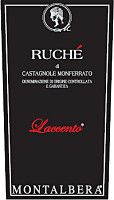
|
|
Ruchè di Castagnole Monferrato Laccento 2018 |
|
| Montalbera (Piedmont, Italy) | |
 Ruchè Ruchè | |
| Price: € 13.90 | Score: |
 Brilliant ruby red and nuances of ruby red, moderate transparency. Brilliant ruby red and nuances of ruby red, moderate transparency. Intense, clean, pleasing, refined and elegant, starts with hints of
cherry, strawberry and rose followed by aromas of raspberry, violet,
cyclamen, plum, pomegranate, blueberry and black pepper. Intense, clean, pleasing, refined and elegant, starts with hints of
cherry, strawberry and rose followed by aromas of raspberry, violet,
cyclamen, plum, pomegranate, blueberry and black pepper.
 Properly tannic attack and however balanced by alcohol, good body,
intense flavors, pleasing crispness. Properly tannic attack and however balanced by alcohol, good body,
intense flavors, pleasing crispness.
 Persistent finish with flavors of cherry, strawberry and raspberry. Persistent finish with flavors of cherry, strawberry and raspberry. Aged in steel tanks. Aged in steel tanks. |
|
 Meat appetizers, Cold cuts, Pasta with meat and mushrooms, Sauteed meat, Roasted white meat Meat appetizers, Cold cuts, Pasta with meat and mushrooms, Sauteed meat, Roasted white meat |
|
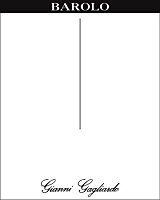
|
|
Barolo 2015 |
|
| Gianni Gagliardo (Piedmont, Italy) | |
 Nebbiolo Nebbiolo | |
| Price: € 35.00 | Score: |
 Brilliant ruby red and nuances of garnet red, moderate transparency. Brilliant ruby red and nuances of garnet red, moderate transparency. Intense, clean, pleasing, refined and elegant, starts with hints of
cherry, plum and violet followed by aromas of raspberry, dried rose,
chocolate, tobacco, leather, licorice, mace, cinnamon, vanilla and menthol. Intense, clean, pleasing, refined and elegant, starts with hints of
cherry, plum and violet followed by aromas of raspberry, dried rose,
chocolate, tobacco, leather, licorice, mace, cinnamon, vanilla and menthol.
 Tannic attack and however balanced by alcohol, full body, intense
flavors, pleasing crispness. Tannic attack and however balanced by alcohol, full body, intense
flavors, pleasing crispness.
 Persistent finish with flavors of cherry, plum and raspberry. Persistent finish with flavors of cherry, plum and raspberry. 33 months in cask. 33 months in cask. |
|
 Game, Roasted meat, Stewed and braised meat, Hard cheese Game, Roasted meat, Stewed and braised meat, Hard cheese |
|
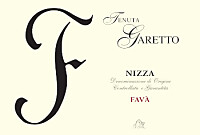
|
|
Nizza Favà 2016 |
|
| Tenuta Garetto (Piedmont, Italy) | |
 Barbera Barbera | |
| Price: € 19.50 | Score: |
 Intense ruby red and nuances of ruby red, little transparency. Intense ruby red and nuances of ruby red, little transparency. Intense, clean, pleasing, refined and elegant, starts with hints of
cherry, plum and raspberry followed by aromas of violet, blueberry,
blackberry, tobacco, chocolate, toffee, mace, vanilla and menthol. Intense, clean, pleasing, refined and elegant, starts with hints of
cherry, plum and raspberry followed by aromas of violet, blueberry,
blackberry, tobacco, chocolate, toffee, mace, vanilla and menthol.
 Properly tannic attack and however balanced by alcohol, good body,
intense flavors, pleasing crispness. Properly tannic attack and however balanced by alcohol, good body,
intense flavors, pleasing crispness.
 Persistent finish with flavors of cherry, plum and raspberry. Persistent finish with flavors of cherry, plum and raspberry. 22 months in cask. 22 months in cask. |
|
 Broiled meat and barbecue, Roasted meat, Stewed meat with mushrooms, Cheese Broiled meat and barbecue, Roasted meat, Stewed meat with mushrooms, Cheese |
|
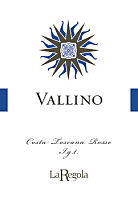
|
|
Vallino 2016 |
|
| La Regola (Tuscany, Italy) | |
 Cabernet Sauvignon, Sangiovese Cabernet Sauvignon, Sangiovese | |
| Price: € 27.00 | Score: |
 Brilliant ruby red and nuances of garnet red, little transparency. Brilliant ruby red and nuances of garnet red, little transparency. Intense, clean, pleasing, refined and elegant, starts with hints of
plum, black currant and raspberry followed by aromas of violet, black
cherry, blueberry, geranium, blackberry, chocolate, tobacco, mace, vanilla
and menthol. Intense, clean, pleasing, refined and elegant, starts with hints of
plum, black currant and raspberry followed by aromas of violet, black
cherry, blueberry, geranium, blackberry, chocolate, tobacco, mace, vanilla
and menthol.
 Properly tannic attack and however balanced by alcohol, good body,
intense flavors, agreeable. Properly tannic attack and however balanced by alcohol, good body,
intense flavors, agreeable.
 Persistent finish with flavors of plum, black currant and black
cherry. Persistent finish with flavors of plum, black currant and black
cherry.
 At least 12 months in barrique, at least 12 months in bottle. At least 12 months in barrique, at least 12 months in bottle. |
|
 Broiled meat and barbecue, Roasted meat, Stewed meat with mushrooms, Hard cheese Broiled meat and barbecue, Roasted meat, Stewed meat with mushrooms, Hard cheese |
|
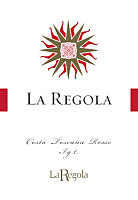
|
|
La Regola 2016 |
|
| La Regola (Tuscany, Italy) | |
 Cabernet Franc Cabernet Franc | |
| Price: € 74.00 | Score: |
 Intense ruby red and nuances of ruby red, little transparency. Intense ruby red and nuances of ruby red, little transparency. Intense, clean, pleasing, refined and elegant, starts with hints of
black currant, plum and black cherry followed by aromas of violet,
blueberry, raspberry, green bell pepper, chocolate, tobacco, leather,
licorice, mace, vanilla and eucalyptus. Intense, clean, pleasing, refined and elegant, starts with hints of
black currant, plum and black cherry followed by aromas of violet,
blueberry, raspberry, green bell pepper, chocolate, tobacco, leather,
licorice, mace, vanilla and eucalyptus.
 Properly tannic attack and however balanced by alcohol, good body,
intense flavors, agreeable. Properly tannic attack and however balanced by alcohol, good body,
intense flavors, agreeable.
 Very persistent finish with long flavors of black currant, plum and
black cherry. Very persistent finish with long flavors of black currant, plum and
black cherry.
 At least 18 months in barrique, at least 12 months in bottle. At least 18 months in barrique, at least 12 months in bottle. |
|
 Roasted meat, Stewed and braised meat with mushrooms, Cheese Roasted meat, Stewed and braised meat with mushrooms, Cheese |
|
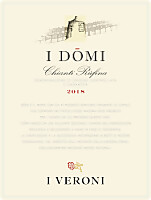
|
|
Chianti Rufina I Domi 2018 |
|
| I Veroni (Tuscany, Italy) | |
 Sangiovese (90%), Canaiolo (5%), Colorino (5%) Sangiovese (90%), Canaiolo (5%), Colorino (5%) | |
| Price: € 11.00 | Score: |
 Brilliant ruby red and nuances of ruby red, moderate transparency. Brilliant ruby red and nuances of ruby red, moderate transparency. Intense, clean, pleasing and refined, starts with hints of black
cherry, plum and raspberry followed by aromas of violet, blueberry,
geranium, carob, mace, vanilla and menthol. Intense, clean, pleasing and refined, starts with hints of black
cherry, plum and raspberry followed by aromas of violet, blueberry,
geranium, carob, mace, vanilla and menthol.
 Properly tannic attack and however balanced by alcohol, good body,
intense flavors, agreeable. Properly tannic attack and however balanced by alcohol, good body,
intense flavors, agreeable.
 Persistent finish with flavors of black cherry, plum and raspberry. Persistent finish with flavors of black cherry, plum and raspberry. 12 months in cask, 10 months in bottle. 12 months in cask, 10 months in bottle. |
|
 Broiled meat and barbecue, Roasted meat, Stewed meat with mushrooms, Cheese Broiled meat and barbecue, Roasted meat, Stewed meat with mushrooms, Cheese |
|
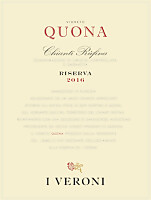
|
|
Chianti Rufina Riserva Quona 2016 |
|
| I Veroni (Tuscany, Italy) | |
 Sangiovese Sangiovese | |
| Price: € 21.00 | Score: |
 Brilliant ruby red and nuances of garnet red, little transparency. Brilliant ruby red and nuances of garnet red, little transparency. Intense, clean, pleasing, refined and elegant, starts with hints of
black cherry, plum and dried violet followed by aromas of blueberry,
blackberry, cocoa, tobacco, cinnamon, leather, vanilla and menthol. Intense, clean, pleasing, refined and elegant, starts with hints of
black cherry, plum and dried violet followed by aromas of blueberry,
blackberry, cocoa, tobacco, cinnamon, leather, vanilla and menthol.
 Properly tannic attack and however balanced by alcohol, good body,
intense flavors, agreeable. Properly tannic attack and however balanced by alcohol, good body,
intense flavors, agreeable.
 Persistent finish with flavors of black cherry, plum and blackberry. Persistent finish with flavors of black cherry, plum and blackberry. 18 months in cask and barrique, 12 months in bottle. 18 months in cask and barrique, 12 months in bottle. |
|
 Broiled meat and barbecue, Roasted meat, Stewed meat with mushrooms, Cheese Broiled meat and barbecue, Roasted meat, Stewed meat with mushrooms, Cheese |
|
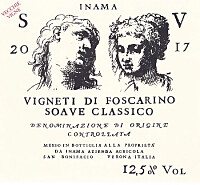
|
|
Soave Classico Vigneti di Foscarino 2017 |
|
| Inama (Veneto, Italy) | |
 Garganega Garganega | |
| Price: € 19.50 | Score: |
 Intense golden yellow and nuances of golden yellow, very transparent. Intense golden yellow and nuances of golden yellow, very transparent. Intense, clean, pleasing, refined and elegant, starts with hints of
apple, plum and citrus fruits followed by aromas of pear, hawthorn,
chamomile, broom, peach, grapefruit, mango and almond. Intense, clean, pleasing, refined and elegant, starts with hints of
apple, plum and citrus fruits followed by aromas of pear, hawthorn,
chamomile, broom, peach, grapefruit, mango and almond.
 Crisp attack and however balanced by alcohol, good body, intense
flavors, pleasing roundness, Crisp attack and however balanced by alcohol, good body, intense
flavors, pleasing roundness,
 Persistent finish with flavors of plum, apple and almond. Persistent finish with flavors of plum, apple and almond. Fermented and aged in barrique for 6 months, 6 months in steel tanks. Fermented and aged in barrique for 6 months, 6 months in steel tanks. |
|
 Pasta and risotto with fish, Stewed fish with mushrooms, Sauteed white meat, Roasted fish Pasta and risotto with fish, Stewed fish with mushrooms, Sauteed white meat, Roasted fish |
|
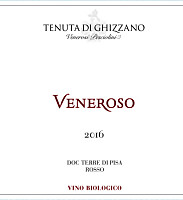
|
|
Veneroso 2016 |
|
| Tenuta di Ghizzano (Tuscany, Italy) | |
 Sangiovese (70%), Cabernet Sauvignon (30%) Sangiovese (70%), Cabernet Sauvignon (30%) | |
| Price: € 23.00 | Score: |
 Intense ruby red and nuances of garnet red, little transparency. Intense ruby red and nuances of garnet red, little transparency. Intense, clean, pleasing, refined and elegant, starts with hints of
black cherry, plum and black currant followed by aromas of dried violet,
blueberry, blackberry, tobacco, chocolate, face powder, mace, vanilla and
menthol. Intense, clean, pleasing, refined and elegant, starts with hints of
black cherry, plum and black currant followed by aromas of dried violet,
blueberry, blackberry, tobacco, chocolate, face powder, mace, vanilla and
menthol.
 Properly tannic attack and however balanced by alcohol, good body,
intense flavors, agreeable. Properly tannic attack and however balanced by alcohol, good body,
intense flavors, agreeable.
 Persistent finish with flavors of black cherry, plum and black currant. Persistent finish with flavors of black cherry, plum and black currant. 16 months in cask. 16 months in cask. |
|
 Roasted meat, Broiled meat and barbecue, Stewed meat with mushrooms, Hard cheese Roasted meat, Broiled meat and barbecue, Stewed meat with mushrooms, Hard cheese |
|
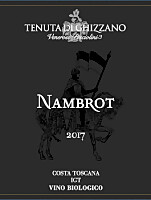
|
|
Nambrot 2017 |
|
| Tenuta di Ghizzano (Tuscany, Italy) | |
 Merlot (60%), Cabernet Franc (20%), Petit Verdot (20%) Merlot (60%), Cabernet Franc (20%), Petit Verdot (20%) | |
| Price: € 40.00 | Score: |
 Intense ruby red and nuances of ruby red, little transparency. Intense ruby red and nuances of ruby red, little transparency. Intense, clean, pleasing, refined and elegant, starts with hints of
black currant, black cherry and plum followed by aromas of violet,
blueberry, blackberry, chocolate, tobacco, black pepper, cinnamon,
licorice, mace, vanilla and eucalyptus. Intense, clean, pleasing, refined and elegant, starts with hints of
black currant, black cherry and plum followed by aromas of violet,
blueberry, blackberry, chocolate, tobacco, black pepper, cinnamon,
licorice, mace, vanilla and eucalyptus.
 Tannic attack and however balanced by alcohol, full body, intense
flavors, pleasing roundness. Tannic attack and however balanced by alcohol, full body, intense
flavors, pleasing roundness.
 Very persistent finish with long flavors of black currant, plum and
blueberry. Very persistent finish with long flavors of black currant, plum and
blueberry.
 18 months in barrique. 18 months in barrique. |
|
 Game, Roasted meat, Braised and stewed meat, Hard cheese Game, Roasted meat, Braised and stewed meat, Hard cheese |
|
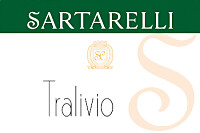
|
|
Verdicchio dei Castelli di Jesi Classico Superiore Tralivio 2018 |
|
| Sartarelli (Marches, Italy) | |
 Verdicchio Verdicchio | |
| Price: € 17.00 | Score: |
 Brilliant straw yellow and nuances of straw yellow, very transparent. Brilliant straw yellow and nuances of straw yellow, very transparent. Intense, clean, pleasing and refined, starts with hints of apple, plum
and hawthorn followed by aromas of pear, citrus fruits, peach, broom,
anise, pineapple and almond. Intense, clean, pleasing and refined, starts with hints of apple, plum
and hawthorn followed by aromas of pear, citrus fruits, peach, broom,
anise, pineapple and almond.
 Crisp attack and however balanced by alcohol, good body, intense
flavors, agreeable. Crisp attack and however balanced by alcohol, good body, intense
flavors, agreeable.
 Persistent finish with flavors of apple, plum and almond. Persistent finish with flavors of apple, plum and almond. Aged in steel tanks. Aged in steel tanks. |
|
 Broiled fish, Roasted white meat, Fish soups and mushrooms, Stuffed pasta Broiled fish, Roasted white meat, Fish soups and mushrooms, Stuffed pasta |
|
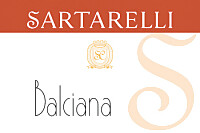
|
|
Verdicchio dei Castelli di Jesi Classico Superiore Balciana 2017 |
|
| Sartarelli (Marches, Italy) | |
 Verdicchio Verdicchio | |
| Price: € 38.00 | Score: |
 Intense golden yellow and nuances of golden yellow, very transparent. Intense golden yellow and nuances of golden yellow, very transparent. Intense, clean, pleasing, refined and elegant, starts with hints of
quince, apricot and medlar followed by aromas of citrus fruits, hawthorn,
plum, peach, noble rot, broom, pear jam, mango, chamomile, linden, saffron,
honey and almond. Intense, clean, pleasing, refined and elegant, starts with hints of
quince, apricot and medlar followed by aromas of citrus fruits, hawthorn,
plum, peach, noble rot, broom, pear jam, mango, chamomile, linden, saffron,
honey and almond.
 Crisp attack and however balanced by alcohol, full body, intense
flavors, pleasing roundness. Crisp attack and however balanced by alcohol, full body, intense
flavors, pleasing roundness.
 Very persistent finish with long flavors of quince, apricot and almond. Very persistent finish with long flavors of quince, apricot and almond. Aged in steel tanks. Aged in steel tanks. |
|
 Stuffed pasta with mushrooms, Roasted fish, Roasted white meat, Cheese Stuffed pasta with mushrooms, Roasted fish, Roasted white meat, Cheese |
|
|
||||||||
|
DiWineTaste Polls
|
| |||||||
Privacy Policy | |||||||


| Copyright © 2002-2024 Antonello Biancalana, DiWineTaste - All rights reserved |
| All rights reserved under international copyright conventions. No part of this publication and of this WEB site may be
reproduced or utilized in any form or by any means, electronic or mechanical, without permission in writing from DiWineTaste. |